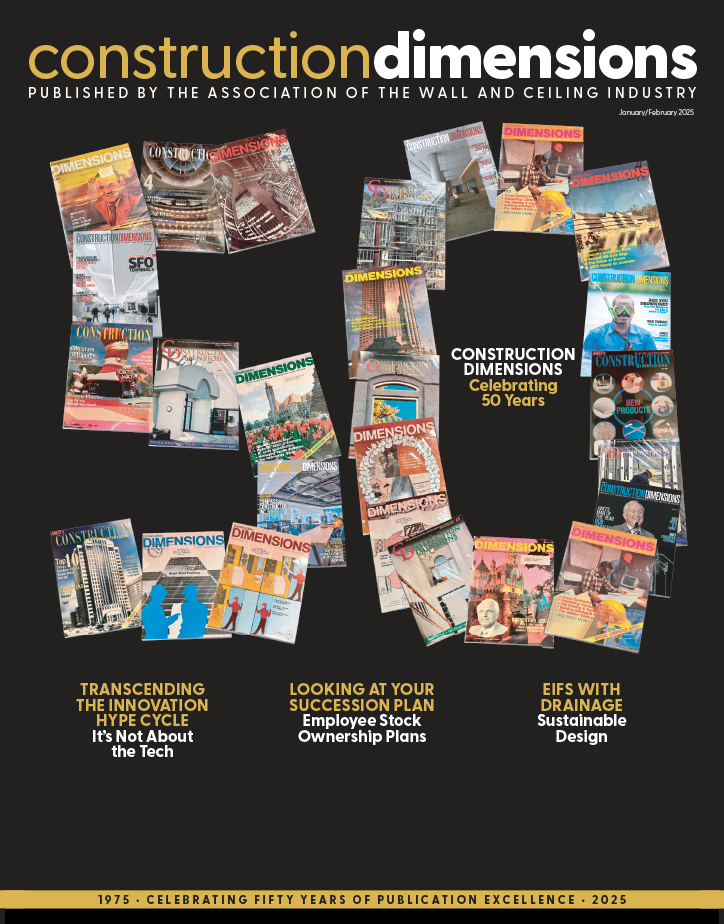In the building construction industry, we all have to work within the building codes—the rules for how buildings are constructed. But how do the codes get written and adopted into law, and what influence can we as wall and ceiling contractors have on these rules?
As with any law, the public has a say at some point in the process about what should be included or excluded. But often by the time these rules get to the public comment period, it is too late to make any substantive change. The core of code advocacy starts at the beginning of the formal code development process, with the companies and associations that develop the codes. Organizations that have a stake in building construction, such as the Gypsum Association, Wall and Ceiling Conference, Steel Framing Industry Association, National Association of Homebuilders and AWCI, all participate in some form in the code development process. Here is a brief summary of the process, some recent changes that affect our industry, and how you can become more engaged.
Building construction requirements have three tiers. The first includes the codes that are adopted into law in the jurisdiction where the building is being built. The primary code that fits this description is the International Building Code. There are also specific codes for performance and systems: fire codes, energy conservation codes and mechanical and plumbing codes.
The second-tier requirements come from consensus standards: documents from organizations like ASTM International that are adopted by reference in the IBC and are listed in IBC chapter 35. For example, AWCI has developed the “Standard Practice for the Testing and Inspection of Thin-Film Intumescent Fire-Resistive Materials” (AWCI 12-B). This is referenced in section 1705.16 of the IBC.
The third tier of requirements is only tangentially related to building codes; these are referenced by architects and engineers in the contract documents. For example, green building requirements are not expressly included in the building code, but an architect or owner may require compliance with Living Building Challenge or LEED® requirements.
Recent changes that affect our industry are the decision by the American Iron and Steel Institute to stop their building code activities, and the decision by ICC to move to a two-step process for committee action hearings. The ICC process is too complex to describe in detail here, but the short version is that the new process gives another chance for “interested parties” to show support or opposition to a code change.
The AISI decision to end code advocacy took many by surprise in 2023, since this activity has been an essential part of building code development for the past 60 years. The good news is there is a plan for continued maintenance and development of the standards that affect our industry, primarily the S200 standards for steel framing and the S100 standard that has been referenced by the building codes for over 50 years.
The troubling news is there is not yet a plan for code advocacy for the steel framing industry moving forward. In April I attended the first committee action hearings for the 2027 building codes, and three of the former code staff employees of AISI were there but representing other agencies. The good news for wall and ceiling contractors is that there were representatives from the Gypsum Association, the Firestop Contractors International Association, the Wall and Ceiling Conference and, of course, AWCI.
Still, with no full-time code advocacy staff, these associations will need to rely on their members to be attentive and aware of code issues at the city, county and state level, and bring them to the attention of the AWCI Construction Technology Council. This happened a few years ago, when members saw that water-resistive barrier and drainage requirements were being added to the IBC. Members and association staff acted to mitigate burdensome requirements, and in 2022 the AWCI stucco committee published “Stucco and Drainage Planes” to help installers better understand and comply with requirements.
Good or bad, the building codes are always changing, sometimes because new products and processes are being developed, and sometimes because unsafe practices are revealed and rectified. Either way, the codes will have an effect on your business and safety, so staying attentive and engaged will help with both code development and compliance.





